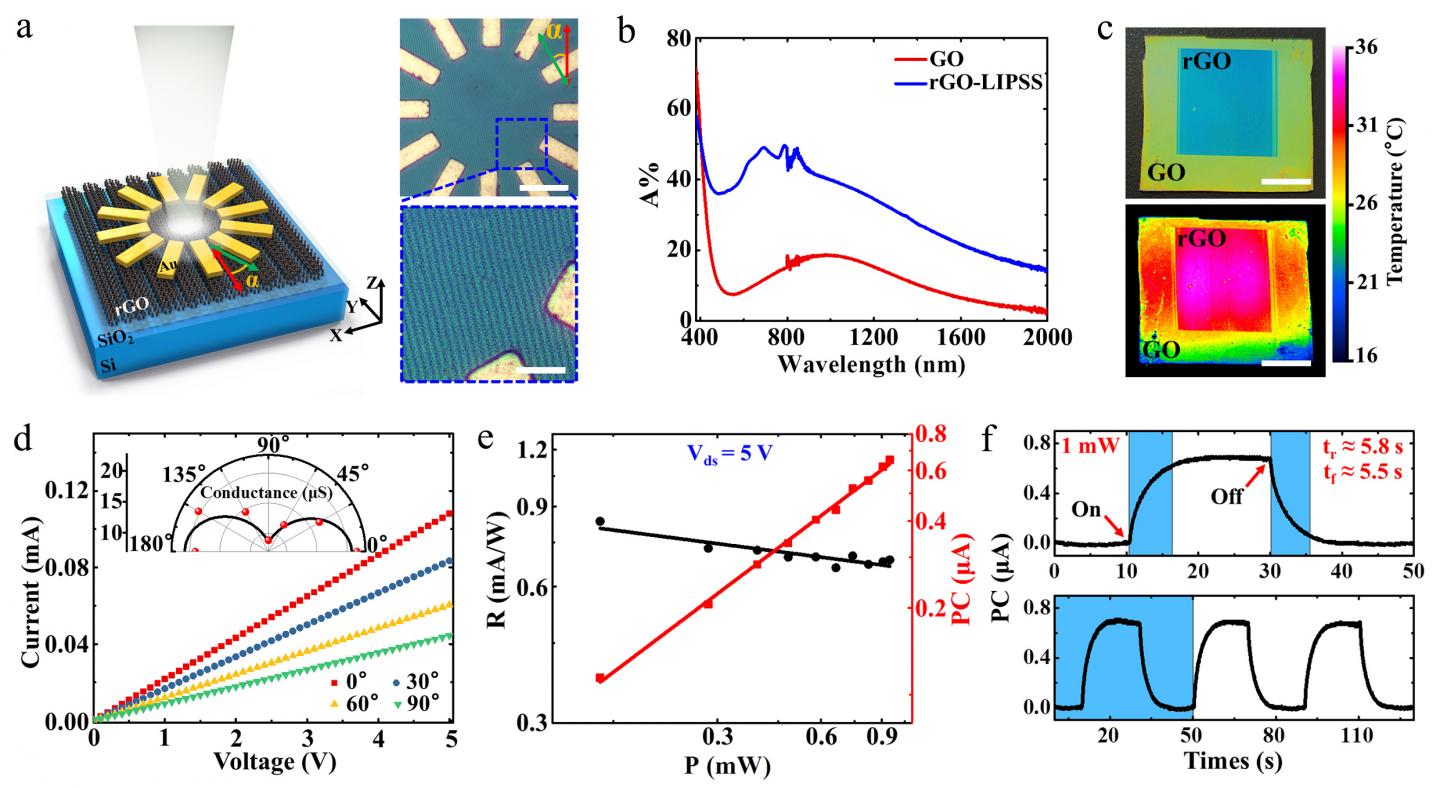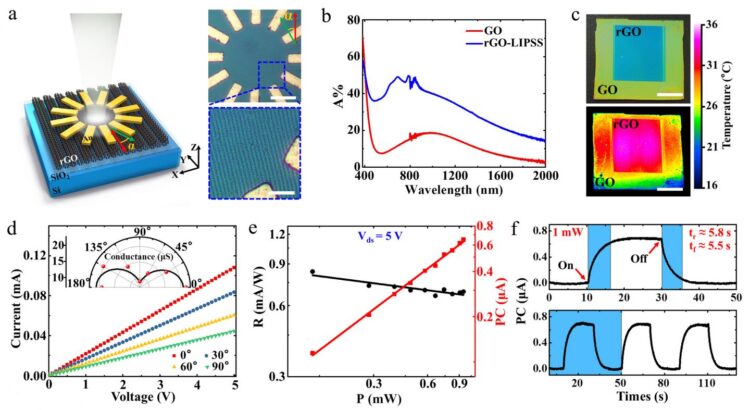
Credit: by Tingting Zou, Bo Zhao, Wei Xin, Ye Wang, Bin Wang, Xin Zheng, Hongbo Xie, Zhiyu Zhang, Jianjun Yang, and Chun-lei Guo
Graphene analogues, such as graphene oxide (GO) and its reduced forms (rGO), are fascinating carbon materials due to the complementary properties endowed by the sp3-sp2 interconversion, revealing the substitutability and potential for industrialization of integrated graphene devices. Appropriate micro/nanostructural design of GO and rGO for controlling the energy band gap and surface chemical activity is important for developing strategic applications. The femtosecond laser plasmonic lithography (FPL) technology is a qualified candidate for generating the required structures due to its efficiency, high-quality, flexibility and controllability. However, as both the theoretical and experimental explorations of this method are still in their infancy, micro/nanoprocessing of graphene materials using FPL has not been realized. The feasibility of implementing the technique in practical applications is still questionable because most related studies only highlight the characteristics of the structure obtained from the processing but often ignore the complementary changes in the properties of the material itself.
In a new paper published in Light Science & Application, scientists from the State Key Laboratory of Applied Optics, Changchun Institute of Optics, Fine Mechanics and Physics, Chinese Academy of Sciences, China, and co-workers presented a high-quality, efficient and large-area periodic micro/nanoripple manufacturing (~680 nm period) and photoreduction of GO films (~140 nm thickness) on a silicon substrate by using the FPL method. Interestingly, unlike most of the reported laser-induced periodic surface structures (LIPSS) in which the pattern alignment is perpendicular to the polarization of the incident light, they are found to have the extraordinary uniform distribution with orientation parallel to each other in this case. Such a phenomenon cannot be explained by the conventional theory of LIPSS, i.e., the interference between the incident light with TM mode and the excited surface plasmon (SP) wave. The analysis demonstrated that the laser-induced gradient reduction of GO film from its surface to the interior plays a key role, and it leads to an inhomogeneous slab with the maximum dielectric permittivity (DP) at the surface and a smaller DP in the interior that allows excitation of TE-mode surface plasmons (TE-SPs) and the subsequent uncommon interference. Due to the diverse physical mechanisms involved in the laser-rGO interaction, the LIPSS formation also exhibited unique characteristics such as strong robustness against a range of perturbations. Because the microprocessing contains no assistant operations, such as chemical etching, the properties of the graphene material are retained, which allows them for optoelectronic applications. As a matter of fact, through modulation of the photoreduction degree and structural design of the rGO surface, they realized the enhanced light absorption (~ 20%), thermal radiation (> 10°C) and anisotropic conductivities (anisotropy ratio ~ 0.46) from this film material. Based on it, they designed an on-chip, broadband photodetector with stable photoresponsivity (R ~ 0.7 mA W-1) even when exposed to light with the low power (0.1 mW). The authors of the paper summarize the significance of this work as follows:
“(1) The FPL technology is used for the first time to realize the preparation of high-quality, efficient and large-scale periodic micro/nanostructures on the surface of graphene materials; (2) The physical mechanisms of the laser-material interaction involved in FPL technology is further improved; (3) Both the structural characteristics and the properties of the processed material itself are taken into account in the application of photoelectric devices.”
“Compared to laser direct writing adopting the same incident laser parameters, our FPL strategy takes only ~1/14000 of the time to process a centimetre-sized sample (1×1.2 cm2). At the same time, due to the possible nonlinear optical property, the FPL strategy induces an obvious ‘self-repairing’ phenomenon, which can effectively guarantee the processing quality. For example, we can prepare rGO-LIPSS films on different substrates and nondestructively transfer them onto other substrates.”
“Our explanation of the experimental phenomena is markedly different from most of the principles at present. This will give us a clearer understanding of the relevant physical processes and lay a solid foundation for the further development of FPL technologies.”
“The structured graphene materials by FPL technology present excellent photoelectric performance. The photoresponsivity is numerically comparable to the response of the samples obtained by other reduction methods (e.g., chemical and thermal) and is much larger than that of typical photoreduced ones. The anisotropy ratio is even larger than that of some natural anisotropic crystals. Our work combines the experimental exploration with the in-depth understanding of high-speed micro/nanopatterning of the regular rGO-LIPSS, which not only benefits fundamental physics but also facilitates the practical development of graphene analogues on the industrial scale. ”
###
Media Contact
Jianjun Yang
[email protected]
Related Journal Article
http://dx.





